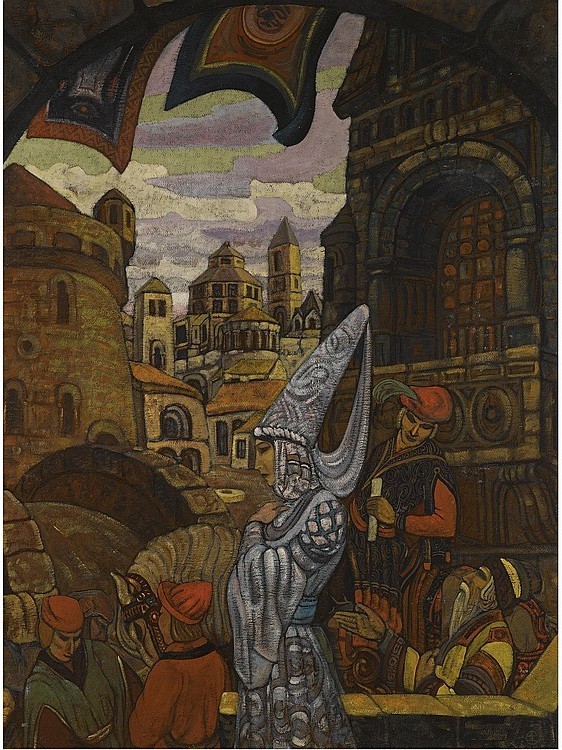 >>
>>
| Картины С.Н.Рериха |
<<  >> >>
| сменить фон |
Ссылка на изображение: http://gallery.facets.ru/pic.php?id=2919&size=3
| |
|
||||||||||||
|
||||||||||||
|
||||||||||||
"Сказка" - прекрасный пример необычайной широты уникальных интересов и художественного стиля Святослава Рериха, описываемого как "отражение его русских корней, западноевропейского и индийского искусства. Это оригинальное смешение столь разных культур сливается в единое целое в его творчестве" (С.Тюлаев, Святослав Рерих, 1977. с.22). Западноевропейская идиома необычна, хотя он начал свое архитектурное образование в Лондоне в 1919 году, и его стилизованное изображение средневековых зданий и арок в "Сказке" одновременно убедительно и напоминает о Средневековье, а также напоминает о богатых и сложных фонах, которые он использовал для достижения такого эффекта в своих портретах.
Его острое чувство истории проявляется как в его письмах, так и в работе. Индию, например, он описал как "живой музей"... Чувство преемственности живо: древний мир и даже доисторическая эпоха, средневековье и современность... все толкаются бок о бок друг с другом и скапливаются в богатом скоплении" (idem, стр.12). Несмотря на европейский контекст данной работы, экзотическая палитра и бородатая фигура справа также намекают на его растущую страсть к Востоку и графические иллюстрации к восточным сказкам 1922 года.
Театр - еще одно важное направление в творчестве Святослава Рериха и мощный элемент настоящей работы. Его интерес к сцене проявлялся с детства, когда они с братом дома создавали костюмы для своего театра. Позже Святослав сотрудничал со своим отцом над декорациями к сказке "Снегурочка", средневековой опере "Князь Игорь" в Лондоне и различным постановкам в Чикагской опере в 1923 году. Его умелое воплощение жанра в этой масштабной картине маслом - дань уважения его многогранности как художника. <..> |
||||||||||||
|
||||||||||||
SVETOSLAV ROERICH FAIRY TALE, CIRCA 1926 Estimate 250,000 — 350,000 GBP LOT SOLD 397,250 GBP Important Russian Art 07 JUN 2010 | LONDON | 7:00 PM BST 25 SVETOSLAV ROERICH FAIRY TALE, CIRCA 1926 Estimate 250,000 — 350,000 GBP LOT SOLD. 397,250 GBP (Hammer Price with Buyer's Premium) signed with artist's monogram and dated 23 l.r. oil on canvas laid on board 130 by 98.5cm, 51 by 38 3/4 in. PROVENANCE Georges Chklaver, Centre Roerich de Paris Acquired by the present owner in 2005 CATALOGUE NOTE Fairytale is a beautiful example of the extraordinary breadth of Svetoslav Roerich's uniquely wide-ranging interests and artistic style, described as 'a reflection of his Russian roots, Western European and Indian art. This original mix of such different cultures blend into a single whole in his work' (S.Tyulaev, Svetoslav Roerich, 1977. p.22). The Western European idiom is unusual, though having begun his architectural training in London in 1919, his stylised depiction of medieval buildings and arches in Fairytale is both convincing and evocative of the Middle Ages, and reminiscent of the rich and complex backgrounds he used to such effect in his portraiture.
His acute sense of history comes through in both his writing and work. India, for example, he described as a 'living museum... The sense of continuity is alive: the ancient world and even the pre-historic era, the Middle Ages and the Modern Age... all jostle alongside one another and amass in a rich conglomeration' (idem, p.12). Despite the European context of the present work, the exotic palette and bearded figure on the right also hint at his burgeoning passion for the East and his graphic illustrations for Oriental fairytales in 1922.
The theatre is another vital strand in Svetoslav Roerich's oeuvre and a powerful element in the present work. His interest in the stage had been nurtured since childhood, when he and his brother used to create costumes for their theatre at home. Svetoslav later collaborated with his father on set designs for the fairy-tale Snegurochka, the medieval opera Prince Igor in London,and various productions at the Chicago Opera in 1923. His skilful incorporation of the genre into this large-scale oil is tribute to his versatility as an artist. We are grateful to Gvido Trepša, Senior Researcher at Nicholas Roerich Museum, New York, for providing additional catalogue information. |
||||||||||||

